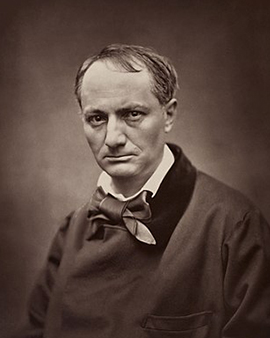The figure of Charles-Pierre Baudelaire, spun in the interactions of the lively art scene of the 19th century, was a pillar of the literary world whose influence still resonates today. A son of Paris, born on April 9, 1821, and passed away in the same city on August 31, 1867, Baudelaire shone as a star in the sky of French poetry. His trademark collection of poems, Les Fleurs du Mal, was instrumental in paving the way for literary modernism in Europe. An art print of Baudelaire would not only provide a snapshot of the poet, but also capture the vibrant spirit of his time. Baudelaire came from a family with an affinity for culture and the arts and was the only child from the second marriage of his father, retired civil servant Joseph-François Baudelaire. His mother, Caroline Aupick, was an émigré who became an orphan at age seven and returned to France. The death of his father when he was just five years old, and the rapid remarriage of his mother, left deep scars on his young heart. Despite his education in the most prestigious schools and a distinguished law degree, Baudelaire was soon attracted to the Parisian artistic and literary bohemia and began to see himself as a writer.
His impetuous spirit and resistance to traditional norms led him into a lifestyle that brought him both debt and a bout of syphilis. Despite several attempts by his family to set him on the "right" path, Baudelaire could not be tamed. He even spent some time on a ship voyage that would take him as far as India, but he only went as far as Mauritius and La Réunion. These islands in the Indian Ocean shaped his imagination and inspired him to write more poems. Even though Baudelaire led a lifestyle that caused him constant money problems, and he struggled with addiction and depression, he left a literary legacy of inestimable value. He translated works by Edgar Allan Poe into French, contributed to the political debate, and wrote numerous poems and short prose himself. His masterpiece "Les Fleurs du Mal" is a perfect example of his revolutionary literary style, in which he expressed the darkness and morbidity of the reality he experienced in Paris with extraordinary artistry.
Baudelaire's unconventional and multifaceted personality is a perfect example of the power and diversity of the human spirit. Each art print of his work is therefore not only a monument to the artist himself, but also a window into the rich history and culture of 19th century France. It is a reflection of the ups and downs of his life, marked by his creativity, passion, struggles and deep melancholy that influenced his work. Moreover, a Baudelaire art print is a tribute to the indomitability of the human spirit, its ability to express itself and find beauty even in the darkest moments of life. It is a testament to his irresistible appeal that led him, against all odds, to leave a lasting legacy in the world of poetry and literature.
×





.jpg)
.jpg)
.jpg)
.jpg)
.jpg)
.jpg)
_(bw_photo)_-_(MeisterDrucke-1078214).jpg)
_(bw_photo)_-_(MeisterDrucke-1078214).jpg)
.jpg)
.jpg)
_reg_-_(MeisterDrucke-1078211).jpg)
_reg_-_(MeisterDrucke-1078211).jpg)
.jpg)
.jpg)
.jpg)
.jpg)
.jpg)
.jpg)
.jpg)
.jpg)
.jpg)
.jpg)
.jpg)
.jpg)
_(bw_photo)_-_(MeisterDrucke-1078212).jpg)
_(bw_photo)_-_(MeisterDrucke-1078212).jpg)
 17th February 1860 - (MeisterDrucke-67661).jpg)
 17th February 1860 - (MeisterDrucke-67661).jpg)
_(bw_photo)_-_(MeisterDrucke-1077776).jpg)
_(bw_photo)_-_(MeisterDrucke-1077776).jpg)
.jpg)
.jpg)
_about_the_painter_Eugene_Delacro_-_(MeisterDrucke-1067177).jpg)
_about_the_painter_Eugene_Delacro_-_(MeisterDrucke-1067177).jpg)
 1858-60 - (MeisterDrucke-51365).jpg)
 1858-60 - (MeisterDrucke-51365).jpg)
.jpg)
.jpg)
.jpg)
.jpg)
 17th February 1860 - (MeisterDrucke-58567).jpg)
 17th February 1860 - (MeisterDrucke-58567).jpg)
_(bw_photo)_-_(MeisterDrucke-1077005).jpg)
_(bw_photo)_-_(MeisterDrucke-1077005).jpg)
 speaking nonsense (pen ink on tra - (MeisterDrucke-264151).jpg)
 speaking nonsense (pen ink on tra - (MeisterDrucke-264151).jpg)
.jpg)
.jpg)
.jpg)
.jpg)
.jpg)
.jpg)
.jpg)
.jpg)
.jpg)
.jpg)
 17th February 1860 - (MeisterDrucke-52801).jpg)
 17th February 1860 - (MeisterDrucke-52801).jpg)
 - (MeisterDrucke-168658).jpg)
 - (MeisterDrucke-168658).jpg)
.jpg)
.jpg)
_-_(MeisterDrucke-315361).jpg)
_-_(MeisterDrucke-315361).jpg)
_(bw_photo)_-_(MeisterDrucke-1077007).jpg)
_(bw_photo)_-_(MeisterDrucke-1077007).jpg)
_re_-_(MeisterDrucke-1078567).jpg)
_re_-_(MeisterDrucke-1078567).jpg)
.jpg)
.jpg)
.jpg)
.jpg)
.jpg)
.jpg)
.jpg)
.jpg)
 1865 (charcoal on paper) - (MeisterDrucke-292594).jpg)
 1865 (charcoal on paper) - (MeisterDrucke-292594).jpg)
.jpg)
.jpg)
_-_(MeisterDrucke-1064662).jpg)
_-_(MeisterDrucke-1064662).jpg)
_(bw_photo)_-_(MeisterDrucke-1077006).jpg)
_(bw_photo)_-_(MeisterDrucke-1077006).jpg)
 and Charles Asselineau (1820-74) c1857-58 - (MeisterDrucke-76563).jpg)
 and Charles Asselineau (1820-74) c1857-58 - (MeisterDrucke-76563).jpg)
.jpg)
.jpg)
.jpg)
.jpg)
 17th February 1860 (pen and ink on paper) - (MeisterDrucke-105430).jpg)
 17th February 1860 (pen and ink on paper) - (MeisterDrucke-105430).jpg)
.jpg)
.jpg)
.jpg)
.jpg)
.jpg)
.jpg)
.jpg)
.jpg)






